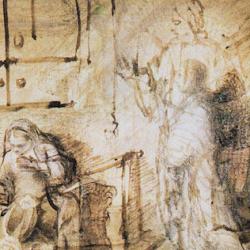Isaiah 53 has often been read as a text dealing mainly with “atonement theory.” That is, it is a text that explains the mechanics of how the atonement dealt with sin. That is certainly part of what we’ll find, but the text itself is really more a prediction of the passion of the Servant Messiah rather than a treatise on atonement theology. It’s like Psalm 22 or 69, or Zechariah 11 and 13, all of which are quoted in the gospels to highlight the fact that the events of Jesus’ life and death fulfill prophecy. This is evident from the way the New Testament uses the passage.
Matthew 8:17 makes little sense if we see it as atonement theology. There, Matthew quotes Isaiah 53’s statement about the Servant bearing the infirmities and sicknesses of Israel and says that it is fulfilled in the healing ministry of Jesus. Jesus bears the sicknesses of Israel not by dying but by healing. He becomes the sickness-bearer by healing. This could mean that He took on the infirmities of the people He healed, or it could simply mean that He carried them away. In any case, Isaiah 53 is not treated as a theory but as a prophecy about Jesus activities.
The same is true of the passages in Matthew that quote from or allude to Isaiah 53 in the passion narrative. Jesus is silent before the High Priest and Pilate (26:63; 27:12-14), just as Isaiah 53 predicted. Matthew 27:57-60 is clearly alluding back to the end of Isaiah 53’s predictions about the Servant’s death.
Isaiah 53 is fundamentally a prediction of what will happen to the Servant, and not a theory about why it happened or how it worked. Again, we can draw some conclusions about the mechanics of atonement from this passage, but the focus lies elsewhere.
One of the dangers of reading the text as a theory instead of as a narrative is that we assume that everything the text says is objectively true, that it is actually what is happening. We miss the variety of voices and characters. There are at least three characters involved. It’s a drama.
First, there is someone who calls the Servant “My Servant” (52:12). Where this phrase occurs elsewhere, it is the Lord speaking of His Servant. That means there is also the Servant, who is the “he” throughout the passage. He is the one who grows like a shoot, who is unattractive, who is despised and forsaken, who is oppressed and yet does not open His mouth. And then, crucially, there is a “we,” a plural group of characters. That comes up in verse 1 – “our message” – but that’s a confusing instance. At the end of verse 2, we first hear of the reaction of this group to the Servant. “We” didn’t want to look at Him, and did not esteem Him. But it is also “we” who esteemed Him stricken, smitten, and afflicted (v. 4). Despite the hymnic tradition, this is not Isaiah’s or the Lord’s evaluation of the Servant. He is not stricken by God. That is how the people regard Him, at least initially.
Who did strike and smite Him then? The structural analysis we did at the beginning gives us the answer: In Isaiah 50, the Servant with the open ear and the loosed tongue meet opposition from the people. They strike Him, spit in His face, despise Him, pluck out His beard. If the Servant of Isaiah 53 is disfigured, it’s the people themselves who have done it.
Given the variety of characters and the nature of the passage, we can now see the real drama of the passage. It is about the Suffering Servant, but it is equally, and narratively more importantly, about the shift in perspective that the people experience in their regard for the Servant. Initially they despise and reject Him. They consider Him to be an enemy of God. But then they confess that they are the ones who have turned away, and they recognize that the sins that the Servant bears, the sins for which He is disfigured and battered, are not His own sins but the people’s. They inflict the beatings on the Servant, and that act of injustice is the means by which the Servant becomes the bearer of their sins.
Isaiah 53 contributes to atonement theory, but it does so properly only when read first as drama.














